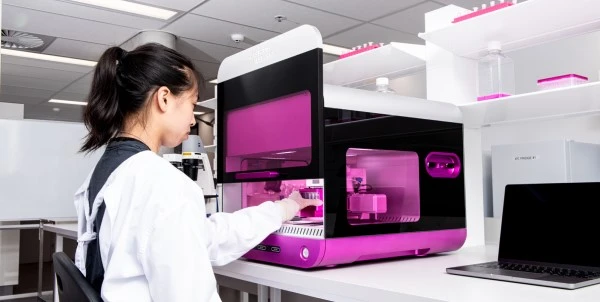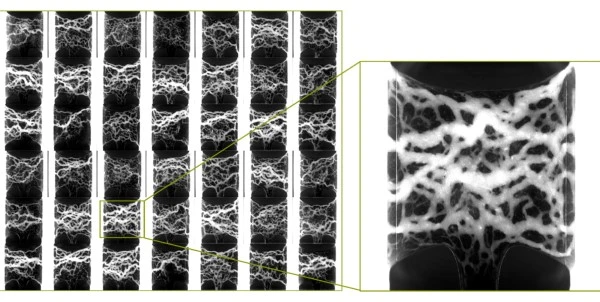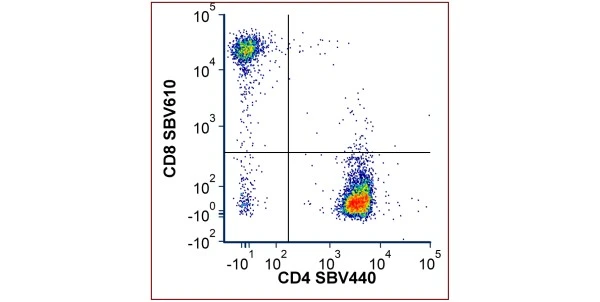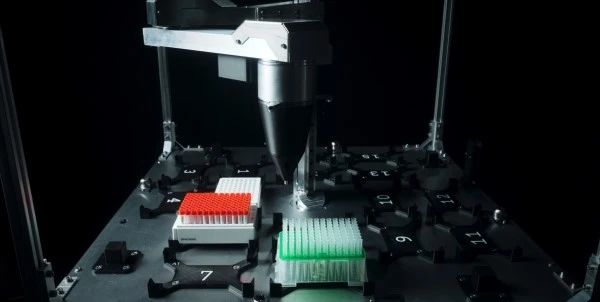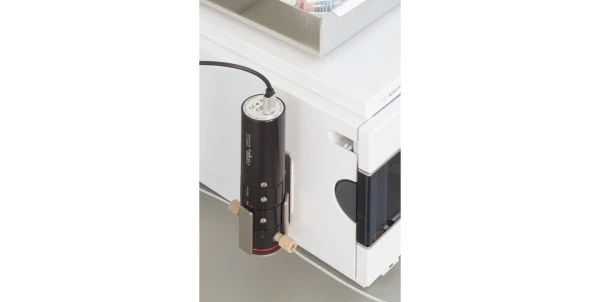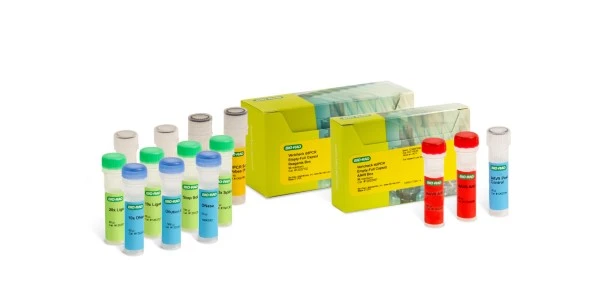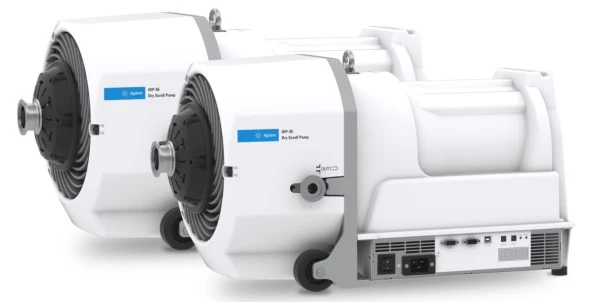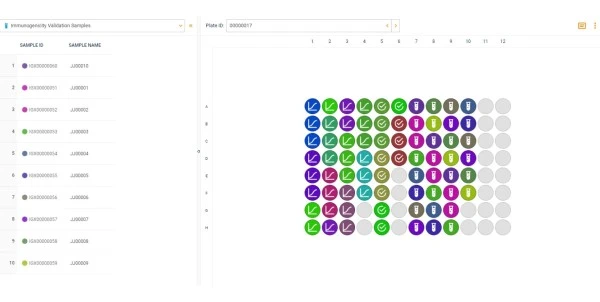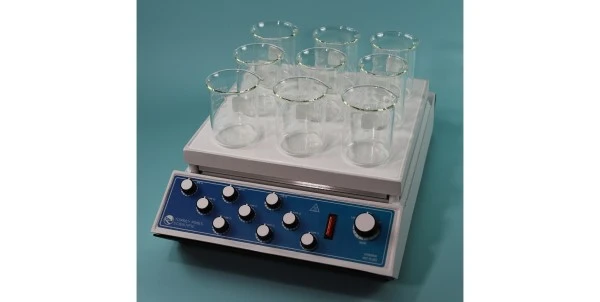
Tecan Announces New Enabling Solutions Targeting Key Areas in Lab Automation, Liquid Biopsy, and Automated Cell Culture Analysis
The Society for Lab Automation and Screening (SLAS) conference was alive this year, abuzz with brilliant minds and engaging conversations.
Innovations in instrument automation and screening—perennial strongholds of the show—were abundant this year. Beyond the instrumentation, however, there was a special enthusiasm and theme that stood above the rest—solutions.
Solutions in lab automation for data and workflow management. Solutions for bottlenecks in screening and diagnostic workflows. Solutions for limitations in automated cell analysis and cell-based screening. The theme seemed to propagate across the audience of vendors and attendees who are looking beyond the instruments and into the realm of innovative solutions to workflow challenges.
Digital Solutions
Tecan presented several exciting announcements and new products at the conference. First on the roster, Tecan unveiled LabNavigatorTM and Next-Gen IntrospectTM as new tools to empower researchers and technicians with digitized lab operation solutions. LabNavigator is an intuitive digital product that guides lab operators through end-to-end workflows, making automation more accessible while reducing errors and ensuring reproducibility. Next-Gen Introspect, which will be commercially released in Q2 2024, is a state-of-the-art laboratory insights tool that builds on Tecan’s well-established platform, Introspect. This next generation platform employs advanced data science to convert instrument and workflow data into actionable insights intended to maximize the utilization, quality, and performance of instrument fleets.
Training someone on a new workflow or trying to update an existing one can be a time-consuming process. While individual workflows and standard operating procedures (SOPs) can vary in length and complexity, most labs have far more than one SOP that new technicians need to learn quickly to begin producing usable data. To compound this challenge, the traditional written SOPs can be difficult to visualize and are static, making adding changes a challenge.
The LabNavigator software helps overcome these difficulties by providing a cloud-based solution where researchers can map out workflows in their entirety. Instead of a standard, written SOP, individuals can now be trained using a multimedia approach, helping to bring new lab workers up to speed much more comprehensively and efficiently without the need for constant supervision. Additionally, LabNavigator allows workflows to be updated in realtime, preventing SOPs from becoming obsolete. “It's a cloud-based software that can be tweaked, changed, updated,” says Philip Ferralli, Associate VP of Market Development at Tecan. “The admin can go and make an adjustment and then it goes live to everybody. So you don't have to worry about someone running an old version because you're constantly able to refresh it. And then, as you need new SOPs, you can build those in the background and push them live to the system that everyone else has access to.”
By incorporating LabNavigator into the digital management of your lab, Tecan hopes to improve the reproducibility, productivity, and the time to train lab personnel in labs all over the world. LabNavigator wasn’t the only software announced. Additionally, Tecan unveiled the Next-Gen Introspect, an updated tool designed to provide data and insight on how all the Tecan systems in the lab are performing.
Customers want to know that they are getting a return on their investment when they purchase new equipment, and they also want to be able to maximize the use of that equipment to get the most for their money. Next-Gen Introspect tracks and auto-populates datasets that provide insights into how the systems in the lab are performing.
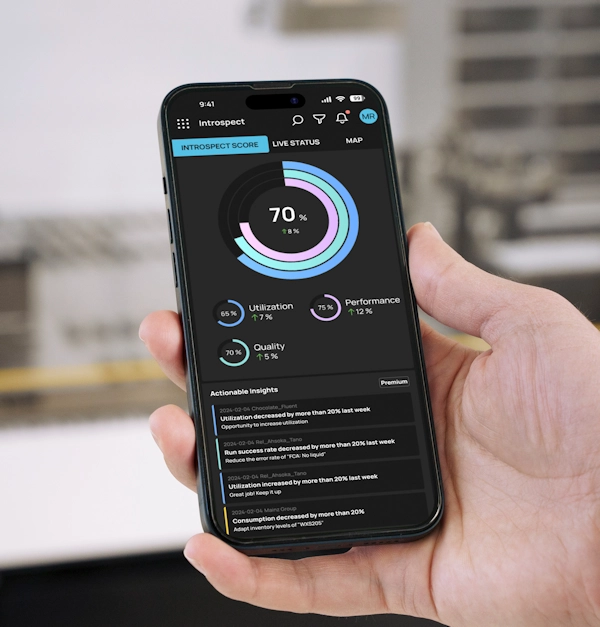 “Right now,
we're focused on Tecan instruments and how those perform—mainly our Fluent® and Freedom EVO® lineup of products,” says Ferralli. “It gives lab managers the ability to quickly
glance and know what's happening. But what's interesting with this one is we've
added some AI driven models into it, where you're not just getting graphs,
you're getting insights into what you should be expecting to see. For many
customers that make a move into automation, it could be their first system or their third, they've never looked at this data before. So, they're
sort of looking at it saying ‘I don't know, what should I expect.’ And now the
system is saying, 'Hey, based on what we know, this system is operating at 20
percent capacity, and you should look at what you're doing.' It's giving them
actionable insights.”
“Right now,
we're focused on Tecan instruments and how those perform—mainly our Fluent® and Freedom EVO® lineup of products,” says Ferralli. “It gives lab managers the ability to quickly
glance and know what's happening. But what's interesting with this one is we've
added some AI driven models into it, where you're not just getting graphs,
you're getting insights into what you should be expecting to see. For many
customers that make a move into automation, it could be their first system or their third, they've never looked at this data before. So, they're
sort of looking at it saying ‘I don't know, what should I expect.’ And now the
system is saying, 'Hey, based on what we know, this system is operating at 20
percent capacity, and you should look at what you're doing.' It's giving them
actionable insights.”
Like LabNavigator, this program is cloud-based, meaning managers don’t have to be in the lab to access the information. Lab managers can check in on the lab and any projects being run from offsite.
An additional great benefit provided by the Next-Gen Introspect is that it helps managers get ahead of the instrument service process, avoiding downtime bottlenecks. Ferralli explained that the Introspect allows Tecan to work with customers to predict and coordinate when maintenance visits may be needed, as well as monitoring the efficiency of frequently used machines and components. “If we can stay ahead of that and say, ‘Hey, before something happens, let's come in and fix it’, [lab managers] don't have to worry about having unexpected downtime. They can plan their experiments in a rotation that allows them to utilize every resource available,” says Ferralli.
With these new digital tools, lab managers can improve the efficiency and productivity of their labs. From streamlining training and keeping SOPs updated and relevant to tracking machine use and maintenance requirements, these tools help researchers and technicians do their jobs while improving their quality of life.
Liquid Biopsy Applications
Switching gears, Tecan went on to announce a streamlined solution portfolio to enable liquid biopsy applications. Leveraging its position as a leader in lab automation, the company showcased solutions intended to accelerate the development, validation, and clinical adoption of liquid biopsy protocols.
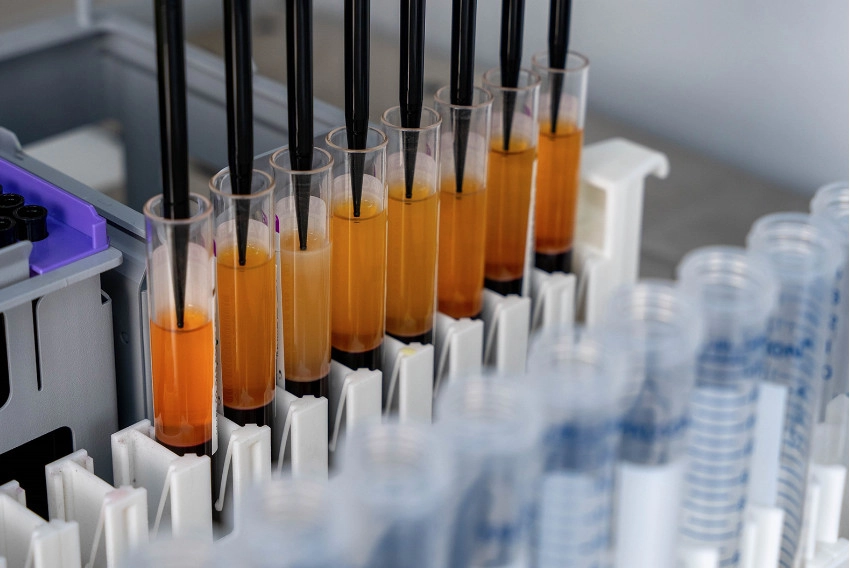 Liquid biopsy is
playing an increasingly important role in the detection, diagnosis, and
monitoring of diseases, especially in oncology. Liquid biopsy has many
advantages over traditional tissue biopsy. It is much less invasive, requiring
processing single blood draw samples. It can provide a much faster time to
results by avoiding traditional pathology analysis. The technique is proving much
more cost-effective and efficient as well.
Liquid biopsy is
playing an increasingly important role in the detection, diagnosis, and
monitoring of diseases, especially in oncology. Liquid biopsy has many
advantages over traditional tissue biopsy. It is much less invasive, requiring
processing single blood draw samples. It can provide a much faster time to
results by avoiding traditional pathology analysis. The technique is proving much
more cost-effective and efficient as well.
The technique is not without challenges, however, and major hurdles include the need for increased precision and accuracy in whole blood handling and processing. Improving and standardizing workflows is a priority for the field as well, to enable handling of challenges, low sample volumes, and minimize the risk of cross-contamination and poor reproducibility, particularly between runs, instruments, and operators.
The streamlined solutions from Tecan are intended to address these challenges directly. “The market has adopted a blood-based workflow of liquid biopsy looking at plasma or buffy coat isolation,” states Ferralli. “We have asked those in the field how we can make the workflow and associated challenges easier and more efficient. So many labs that are performing plasma extraction are getting blood tubes in the clinical environment, bringing them to the lab, and then performing manual centrifugation and density-based separations. Current solutions for blood separation analysis include camera-based detectors. The problem is that these camera systems have trouble viewing samples through labels. Extended time and work are needed to remove and replace the labels, an issue that can be made worse by potentially losing tracking accuracy. Another bottleneck is the need for manually removing the separated phases. The variability in handling, processing time, and precision associated with sample removal are real issues with current camera-based solutions,” says Ferralli.
The patented technology behind Tecan's new Phase SeparatorTM is a significant advancement in the separation of centrifuged blood samples. It provides pressure-based liquid-liquid phase separation as an integral element of the Fluent Automation Workstation's capabilities. “Phase Separator eliminates challenges with blood extraction by using pressure monitoring combined with automated liquid handling. The system scans the tube internally by constantly monitoring pressure as the pipetting tip drops through the sample. When it senses the pressure change at the phase layer separation, it can extract off the appropriate sample and transfer this to separate tubes. Plasma, buffy coat, and red blood cells can be extracted in a highly precise automated method, rather than relying on camera-based detection and manual extraction. We can do eight tubes at a time, with each channel measured individually, performing plasma extraction of up to 24 samples in 10 minutes. That’s twice the speed customers are achieving with existing products and, to them, throughput is everything in the clinic,” explains Ferralli.
From detecting biomarkers to informing precision medicine, liquid biopsy is a bridge that connects upstream diagnostics to genomics-driven therapies. Tecan’s genomics portfolio offers fully automated walkaway solutions—including the well-established DreamPrep® NAP workstation for nucleic acid extraction, and DreamPrep NGS for sample prep—enabling the standardization of technically challenging, high throughput workflows for consistent and reliable sample processing.
Tecan also announced updates to its well-established sample preparation workflows. The Resolvex® i300 positive pressure module is a solid-phase extraction feature that can be integrated with the Fluent Automated Workstation. “Much of the work with liquid biopsies has been focused on ctDNA [circulating tumor DNA] as a measure of the genomic presence or status of cancer and other diseases,” says Ferralli. “There is also another application for liquid biopsy that people are looking into, which involves what the proteomic profile of those tumor cells looks like within the individual patient. If we have insight into tumor status at the proteome level, that can inform how we approach treatment from a personalized medicine perspective.”
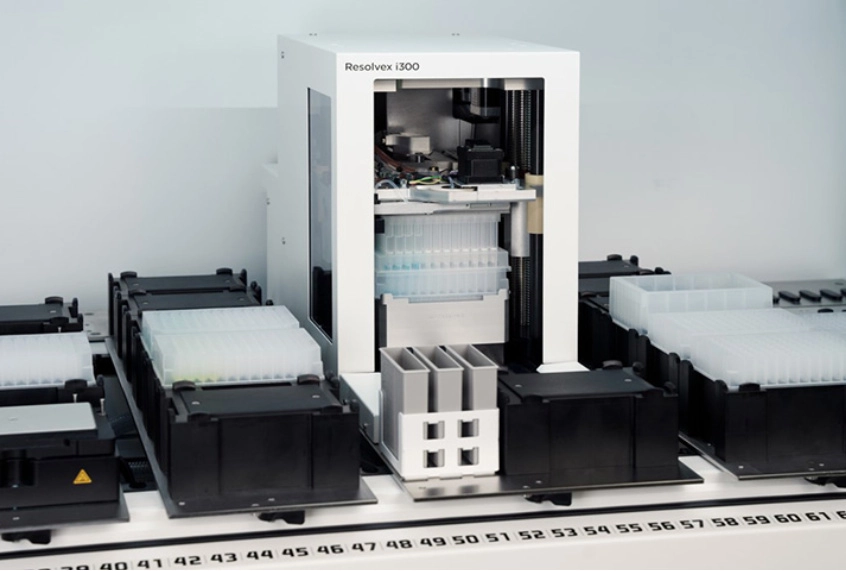 The Resolvex i300 uses positive pressure solid-phase
extraction on the same Fluent platform as the Phase Separator. Both nucleic acid and
protein preparation capabilities are now integrated on a common instrument
platform and are compatible with a range of consumables including those in the
Tecan sample prep portfolio.
The Resolvex i300 uses positive pressure solid-phase
extraction on the same Fluent platform as the Phase Separator. Both nucleic acid and
protein preparation capabilities are now integrated on a common instrument
platform and are compatible with a range of consumables including those in the
Tecan sample prep portfolio.
“The Resolvex i300 offers solid-phase extraction in an automated, integrated, easy-to-use solution,” states Ferralli. “These two enabling technologies support downstream liquid biopsy workflows and get you where you need to be.”
Cell Biology Solutions
Switching gears once again, Tecan announced exciting new solutions for single cell dispensing and automated cell culture applications. The technologies are intended to support reliability, reproducibility, and throughput in the growing fields of single cell and 3D cell biology. Lack of reproducibility continues to be a challenge in many of these workflows, a problem that is being solved with innovative automated solutions with the end goal of helping labs to increase throughput and achieve consistent and reliable workflows.
The Uno Single Cell DispenserTM is an automated benchtop instrument based on proven microfluidic digital dispensing technology. This core technology was originally designed through a collaboration with Hewlett Packard and the release of the D300e Digital Dispenser. “We’ve been lucky enough to work with HP for a couple of years now,” says Ferralli. “The D300e is a solution that, like an inkjet printer, can ‘print’ liquids into a microplate down to picoliter levels. We’ve taken this to the next level by developing a new solution—the Uno Single Cell Dispenser—using the same base technology but refined to be able to handle cells in suspension.”
Starting with a cell suspension loaded in a small cartridge, the user defines the size and dimensions of the collected cells. The instrument then dispenses single cells into each well of a 384-well plate. “Many of our customers are using the instrument for single cell proteomic assays. They have an aliquot of cells and set up a downstream mass spec workflow for conducting full proteome analysis,” describes Ferralli. “The instrument uses a lot of the same software as the D300e, which has proven successful so far for customer ease-of-use. A big deal with this device is that it dispenses cells with 90 percent cell viability. It's gentle on cells, not killing or harming them. The system also auto detects the size of what passes through, and it notifies the user when it detects out of range cell sizes. Cells are essentially screened to be sure artifacts, clumps, and other materials don’t become part of the data. They are flagged and excluded from analysis.”
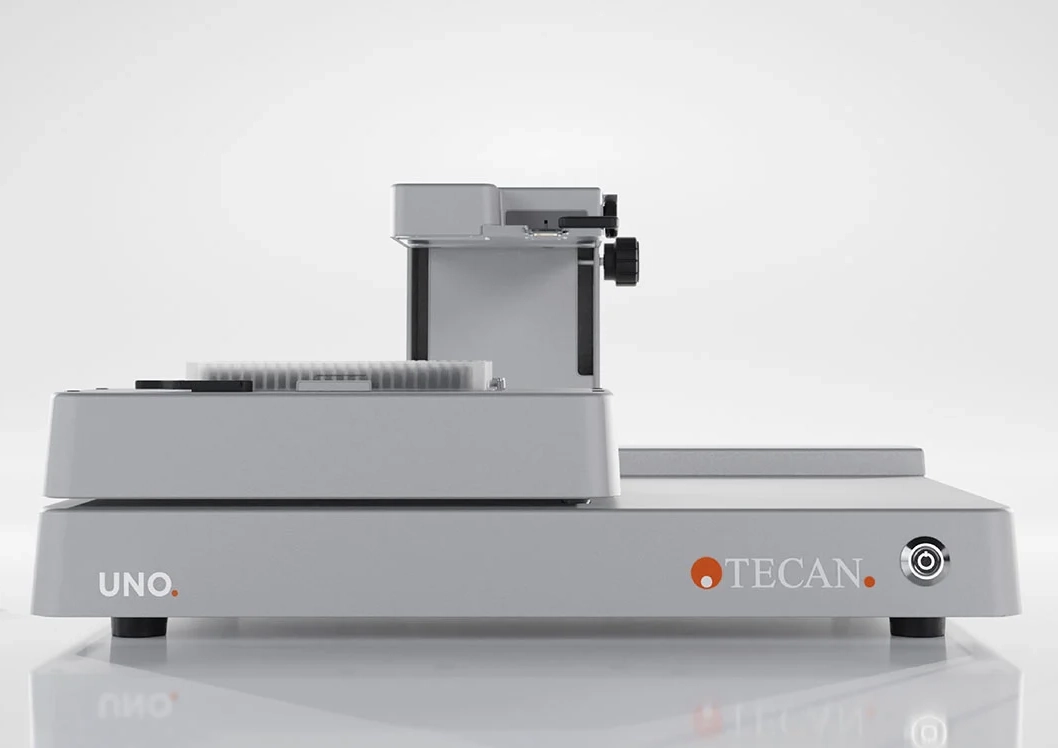 The
Uno Single Cell Dispenser is a benchtop, straightforward, affordable solution for labs performing
single cell experiments and screening assays. “There’s a
lot of innovative thinking that has gone into the device and the getting the
microfluidic chip to manipulate cells correctly. The D300e has a strong consumer
base, and we will build on this with the Uno SIngle Cell Dispenser, since it’s built
on the same backbone and software.”
The
Uno Single Cell Dispenser is a benchtop, straightforward, affordable solution for labs performing
single cell experiments and screening assays. “There’s a
lot of innovative thinking that has gone into the device and the getting the
microfluidic chip to manipulate cells correctly. The D300e has a strong consumer
base, and we will build on this with the Uno SIngle Cell Dispenser, since it’s built
on the same backbone and software.”
Tecan also discussed the Spark® Cyto multimode reader, specifically designed for automated monitoring and assay measurement of live-cell cultures. The instrument provides full environmental control of temperature and gas levels, while supporting both brightfield and fluorescence imaging. It is intended to enable whole-cell imaging of microplates and constant, undisturbed growth for rapid and reliable analysis.
“More and more people are moving away from monolayers and into 3D cell models, such as spheroids and organoids, that better resemble human tissues” says Ferralli. “One of the areas where we are helping to facilitate research and development is in the oncology space. We know people are using tumoroids to better understand and develop solutions to cancer, potential treatments, early-stage detection, and other pursuits. That has fueled our interest in developing technology to image in 3D. Collecting stacks of images by moving in the z-plane and then reconstructing the 3D image presents a huge challenge, not just from a hardware perspective, but also software for the compilation process.”
The Spark Cyto has built-in AI learning models that analyze segmentation and help establish the parameters that define a spheroid in each application. Once the system can identify the correct spheroid, the noise and incorrect cells can be eliminated from analysis. It takes the imaging and computational guesswork out of identifying the correct spheroid.
“The Spark Cyto is not just a multimode plate reader. It’s an incubator with environmental controls, where cell cultures can be grown, and progress can be monitored or perturbed if desired. There are a lot of ways in which this system can integrate into workflows, from an early-stage monitoring piece to an end-of-state detection piece. It has the capability to do 3D cell analysis which unlocks a whole new world for our customers,” states Ferralli.
Beyond Single Instruments and into Equipment Portfolios
With these announcements and developments, it’s clear that Tecan is broadening the horizon of technology solutions for its customers.
“The central theme we are advancing at Tecan now is not necessarily focused on just selling instruments. This was our purpose for a very long time. We’re all about building on that heritage and focusing on empowering customers from research all the way to the clinic,” states Jurgita Strahm, Vice President of Global Marketing at Tecan.
“The way we are doing it is by focusing on applications, enabling workflows, empowering customers with instrumentation, consumables, digital tools, and trying to make workflows more robust, more efficient, and more scalable. The goals are to accelerate the timelines for uncovering disease pathways, support translational research through the understanding of the disease and, eventually, bring solutions—be it diagnostics or treatments or both—to those who need it most, globally, at scale,” explains Strahm. “There are many diseases and an increasing number of solutions, yet these are not necessarily affordable. Our mission is to make sure that everyone who has a problem has access to a solution.”
Image credits: Tecan
